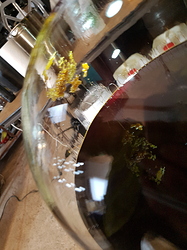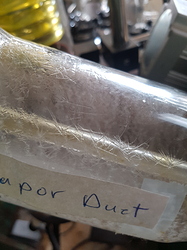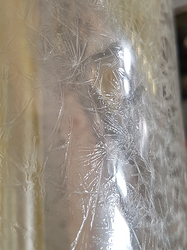What temperature(s) did you start to see ideal amounts of precipitates in the solution with the methanol? Curious if winterization can be done without going as low as ethanol requires.
I’d hazard a guess it’ll just be diminishing returns on temperature. At a certain point it just won’t be worth going colder
The ideal amount of precipitates is none, keep chilling and filtering if stuff is dropping out becausw you dont want to smoke that shit thats precipitating.
Usually around 0F tho the vegetable oil type components drop out and make thw solution very hazy, no defined layer of precipitates.
I definitely could have worded my initial question better. If you’re getting the majority out at 0F that is totally worth looking into. I need to experiment and try putting the filtered solution back into the freezer colder each time and see if anything else drops out of solution the colder it goes.
My freezer doesnt go below 0F so thats just where i stop at. If you used dry ice you would probably be able to get even more to drop from the solution.
You should definitely try to chill your solution colder and re filter, usually some amount of waxes and oils will dissolve back into the solution as the semi saturated solvent passes over the lipids trapped on the surface of your filter.
If you collect the waxes from a warm methanol winterization and evap the solvent, you can compare it with what comes out after you do the same thing with a cold methanol winterization. What comes from the warm filtration is usually pretty greasy but has some stability to it. The cold filtered portion is always a greasy oily mess with no structure to it. This has led me to believe that the waxes that add some kind of stability are the first to preciptate from a methanol solution whereas the oils which would come from the seeds or from pesticides are the last to precipitate in a winterzation procedure.
@Roguelab this answers a question u asked in another thread.
The same waxy substance that make up the cuticle of the leaves when concentrated has a similar consistency/structure as paraffin wax and by itself will add some stability back to a slab.
Wouldnt reccomend it though because its essentially thw same thing as cutting your extract to make more weight. Adding back unhealthy shit for the sake of profit.
Please pardon the necroposting but I didn’t see anyone correctly identify the guck in the OP.
Those are gums (phospholipids?) which have both polar and non-polar components. I noticed they get past winterization in my work unless they are broken apart by enzyme (phospholipidase) and/or (citric) acid or “cooked” out in rotovap with oil bath & high temps 80-100celsius. Sometimes I would find my roto flasks in the morning covered by the stuff if it was left overnight with the bath hot and b.f. loaded with an alcohol extracted resin and under at least some vacuum… even if it was winterized a few times would still show up. It seemed to me that I accidentally “distilled” out the gums by rotovaping at higher than usual temps and since then I have roto’d my alcohol extractions at temps above 80celsius. This almost always resulted in those “sugared” looking deposits which were a pain to clean (at first).
I found that d-Limonene dissolves that pretty well, especially if mixed with water. My preferred mix for cleaning that stuff out of the roto flasks was (roughly speaking) 2 parts hexane 2parts isopropanol 1 part d-Limonene 5 parts distilled water. Then my lab assistant tried a whole bunch of solvents and happened to find that orange hand degreaser/cleaner (containing d-Limonene) on a scrub pad worked the best for cleaning it up, especially when some water was added. That will make short work of the cleaning of those tenacious gums.
See below for some photos of the gums I encountered when roto evaping alcohol extractions (post-winterization). This stuff led me to try out degumming enzyme (works best with LLE/brine wash follow-up) because my distiller started telling me that the EHO crudes were not making good 1st pass distillate (looked “waxy”) like the BHO crude was. Though if I just winterized that “waxy” 1st pass and then they ran a 2nd pass distilling it would come out good. Heat and pressure seem to be able to break apart the gum molecules as do enzymes and acids. I think had my team stayed with BHO crude we wouldn’t have had the issue (lack of polar component grabbing).
Thx! Yah that totally makes sense.
I haven’t had any issues with them since I started louching and brining my extracts ![]()
Nicely done. Using an alkane to pick up the louched resin? Or you got some other tricks up your sleave? ![]()
Hah, I probably have the most step-filled process I know about ![]() yeah once I get a concentrated alcohol extract I brine louche into Pentane.
yeah once I get a concentrated alcohol extract I brine louche into Pentane.
Currently working on isolating acidic cannabinoids with a base after the louche, so then I can have terps on one side and my thc-a isolated on the other.
We’ll see if it works ![]() I try and keep my expectations low as to avoid the constant disappointment.
I try and keep my expectations low as to avoid the constant disappointment.
I made the same mistake trying to decarb in my 50L roto. I have a plug I’m about to try to get worked out. Thanks so much for posting this, huge help in pointing me in the right direction to get this knocked out.





